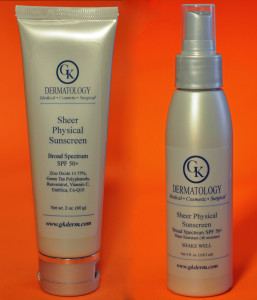Sunscreens: What to Look For
- Posted on: Nov 18 2015
Sunscreens remain the gold standard for photoprotection. Do you know which are safest, or ingredients to avoid? Sunscreens are rated according to their sun protection factor (SPF), mode of action (sunblocks vs. sunscreens), and absorption spectrum. Sunscreens primarily absorb the UV light whereas sunblocks, like Zinc Oxide and Titanium Dioxide, reflect the UV light. A broad-spectrum or full-spectrum sunscreen provides protection from both UV-A and UV-B radiation. To protect against the long UV-A wavelengths, the sunscreen should contain Zinc Oxide, Avobenzone, or Mexoryl as an active ingredient. Sunscreens with SPF 30+ filter more than 97% of the UV-B radiation.
It is important to choose a broad-spectrum, waterproof sunscreen. Also, one should stay away from potentially toxic or irritating ingredients such as Oxybenzone (Benzophenones), Retinyl Palmitate, Methylisothiazolinone, Octinoxate, and Octocrylene. We, at GK Dermatology, have worked hard to identify mineral-containing, broad-spectrum sunblocks that are non-greasy, and do not generate heat in the skin. We believe that sunblocks that are chemical-free generate less heat and sweat than sunscreens because they sit on the skin, and do not significantly penetrate it.
The high-quality, chemical-free, sheer sunscreens at GK Dermatology provide intense photoprotection (SPF 50+), and are easy to apply over moisturizer and under makeup. Therefore, they can be used daily all-year round. Furthermore, our sunscreens contain antioxidants, such as Resveratrol, Embilica, and Green Tea Polyphenols, that combat oxidative damage to the skin which helps in the prevention of skin aging.
Posted in: Skin Care, Sun Protection

